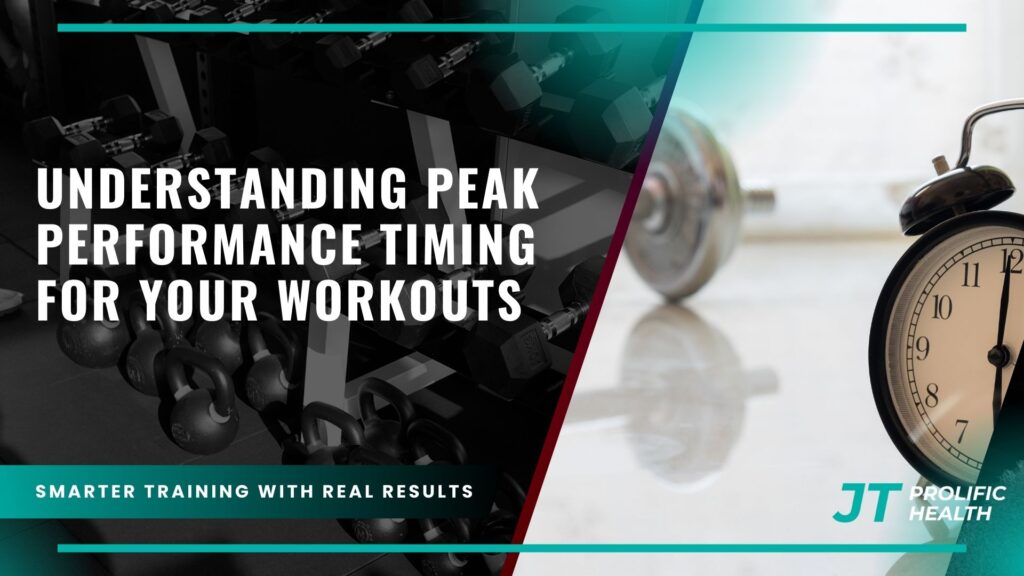Have you ever wondered why some days your workouts feel effortless while others leave you struggling to complete basic exercises? The answer often lies in understanding peak performance timing – the science of aligning your training sessions with your body’s natural rhythms and optimal energy cycles. This concept goes far beyond simply showing up to the gym; it’s about strategically timing your workouts to maximize results, minimize injury risk, and enhance overall athletic performance.
Peak performance timing encompasses multiple factors including circadian rhythms, hormonal fluctuations, body temperature variations, and individual chronotypes. Your body operates on a complex internal clock that influences everything from muscle strength and flexibility to reaction time and perceived exertion. By understanding and leveraging these natural patterns, you can transform mediocre training sessions into highly effective workouts that propel you toward your fitness goals.
The significance of workout timing extends beyond personal preference or schedule convenience. Research consistently demonstrates that the time of day you exercise can impact performance metrics by 10-15%, influence injury rates, and affect how quickly your body recovers between sessions. This knowledge becomes even more crucial when working with professional guidance, as experienced trainers understand how to optimize training schedules based on individual needs and goals.
Modern fitness enthusiasts often overlook this critical component of training, focusing instead on exercise selection, intensity, or nutrition while ignoring when they train. However, elite athletes and sports scientists have long recognized that workout timing for peak performance can be the difference between good results and exceptional outcomes. Whether you’re a competitive athlete, weekend warrior, or someone just beginning their fitness journey, understanding these principles can revolutionize your approach to exercise and help you achieve results more efficiently than ever before.
Key Takeaways
- Circadian rhythm optimization: Your body’s internal clock significantly influences physical performance, with most people experiencing peak strength and power output between 2-6 PM when core body temperature is highest and joints are most mobile.
- Individual chronotype matters: Morning larks and night owls have different optimal training windows, and forcing yourself to train against your natural chronotype can reduce performance by up to 12% compared to training during your preferred time.
- Hormonal timing advantages: Testosterone and growth hormone levels fluctuate throughout the day, with morning workouts potentially offering better fat-burning benefits while afternoon sessions may provide superior strength gains.
- Recovery window considerations: The timing of your workout affects sleep quality, with high-intensity evening sessions potentially disrupting sleep patterns if performed within 3-4 hours of bedtime.
- Consistency trumps perfection: While optimal timing can enhance performance, maintaining a consistent workout schedule that fits your lifestyle is more important than constantly chasing the “perfect” training time.
- Pre-workout preparation timing: Proper warm-up duration, meal timing, and hydration strategies should be adjusted based on when you train, with morning workouts requiring longer warm-ups and different nutritional considerations.
- Performance metrics vary by time: Flexibility, reaction time, and perceived exertion all fluctuate throughout the day, making certain types of training more effective at specific times.
Understanding Your Body’s Natural Performance Cycles

Your body operates on sophisticated biological rhythms that have evolved over millions of years to optimize survival and performance. The most well-known of these is the circadian rhythm, a roughly 24-hour cycle that regulates everything from hormone production to body temperature. Understanding these natural cycles is fundamental to maximizing your workout effectiveness and achieving peak performance timing.
Core body temperature serves as one of the most reliable indicators of when your body is primed for physical activity. Throughout the day, your temperature fluctuates by approximately 1-2 degrees Celsius, reaching its lowest point in the early morning hours and peaking in late afternoon or early evening. This temperature variation directly correlates with muscle function, joint mobility, and overall athletic performance. When your body temperature is higher, your muscles contract more efficiently, your joints move more freely, and your nervous system responds more quickly to training stimuli.
Hormonal fluctuations add another layer of complexity to peak performance timing. Cortisol, often called the stress hormone, naturally peaks in the early morning hours, providing energy and alertness to start the day. This makes morning workouts particularly effective for fat burning, as elevated cortisol levels enhance the body’s ability to mobilize stored fat for energy. Conversely, testosterone levels in men typically peak in the morning and gradually decline throughout the day, while growth hormone production increases during deep sleep and remains elevated in the early morning hours.
The concept of chronotypes – whether you’re naturally a morning person or night owl – significantly influences when you’ll perform best during exercise. Research indicates that approximately 25% of people are natural early birds, 25% are night owls, and the remaining 50% fall somewhere in between. Your chronotype is largely determined by genetics and affects not just when you feel alert, but when your body can generate maximum power, maintain optimal coordination, and recover most effectively from training stress.
Morning Workouts: Advantages and Optimization Strategies


Morning exercise sessions offer unique physiological and psychological advantages that make them an attractive option for many fitness enthusiasts. Training in the morning capitalizes on naturally elevated cortisol levels, which peak between 6-8 AM and provide enhanced energy availability and mental focus. This hormonal environment creates optimal conditions for fat oxidation, making morning workouts particularly effective for those with body composition goals.
The fasted state that naturally occurs upon waking can amplify fat-burning benefits, as glycogen stores are depleted from the overnight fast. This forces your body to rely more heavily on stored fat for energy during exercise. However, this advantage must be balanced against the potential for reduced performance in high-intensity activities, where carbohydrate availability becomes crucial. For those pursuing expert strength training guidance, understanding how to modify morning sessions for optimal results becomes essential.
Morning workouts also provide psychological benefits that extend throughout the day. Completing your exercise session early creates a sense of accomplishment and establishes a positive tone for the remaining hours. Research shows that morning exercisers are more likely to maintain consistent workout schedules and report higher levels of energy and mood stability throughout the day. Additionally, morning training eliminates the risk of afternoon or evening commitments interfering with your fitness routine.
However, morning exercise requires specific optimization strategies to overcome natural physiological limitations. Your core body temperature is at its lowest point upon waking, making muscles and joints less prepared for intense activity. This necessitates longer, more thorough warm-up protocols – typically 10-15 minutes compared to 5-10 minutes for afternoon sessions. Joint mobility is also reduced in the morning, making dynamic stretching and movement preparation crucial for injury prevention.
Hydration status presents another morning challenge, as you naturally become dehydrated during sleep. Beginning your workout in a dehydrated state can impair performance and increase injury risk. Consuming 16-20 ounces of water upon waking and allowing 30-45 minutes before intense exercise helps restore optimal hydration levels. Similarly, blood sugar levels are naturally lower in the morning, so individuals performing high-intensity training may benefit from a small pre-workout snack containing easily digestible carbohydrates.
Afternoon and Evening Training: Peak Performance Windows


Afternoon and early evening hours represent the golden window for peak physical performance, with research consistently demonstrating that most individuals achieve their highest power output, fastest reaction times, and greatest coordination between 2-6 PM. This performance peak coincides with optimal core body temperature, enhanced joint mobility, and ideal hormonal conditions for strength and power development.
The physiological advantages of afternoon training are substantial and measurable. Core body temperature reaches its daily peak during these hours, improving muscle contraction efficiency and reducing the risk of injury. Joints are more mobile due to increased synovial fluid production and improved tissue elasticity. The nervous system operates at peak efficiency, resulting in better coordination, faster reaction times, and enhanced motor unit recruitment – all crucial factors for maximizing training adaptations.
Perceived exertion, or how hard exercise feels, is typically lowest during afternoon hours despite maintaining the same absolute intensity. This psychological advantage allows for longer, more intense training sessions without the mental fatigue that often accompanies morning or late evening workouts. The combination of physiological readiness and reduced perceived effort creates ideal conditions for progressive overload and skill development.
For individuals working with professional fitness guidance, afternoon sessions often provide the best opportunity to learn complex movement patterns and push training intensity. The enhanced coordination and reduced injury risk during these hours make it an ideal time for technique refinement and progressive skill development. Many elite athletes schedule their most important training sessions during this window to capitalize on these natural performance advantages.
However, afternoon and evening training isn’t without challenges. The primary concern involves the potential impact on sleep quality, particularly for high-intensity sessions performed within 3-4 hours of bedtime. Intense exercise elevates core body temperature, increases alertness, and stimulates the sympathetic nervous system – all factors that can interfere with the natural wind-down process necessary for quality sleep. The key lies in understanding your individual response to evening exercise and adjusting intensity and timing accordingly.
Strategic planning becomes crucial for optimizing afternoon and evening workouts. Pre-exercise nutrition should focus on providing adequate energy without causing digestive discomfort, typically involving a balanced meal 2-3 hours before training or a smaller snack 30-60 minutes prior. Hydration needs are different from morning sessions, as you’ve had the entire day to maintain fluid balance, but you must account for any fluid losses from daily activities.
Individual Factors That Influence Optimal Workout Timing
While general principles of peak performance timing provide valuable guidance, individual factors play an equally important role in determining when you’ll perform best during exercise. Age, fitness level, training history, work schedule, family commitments, and personal preferences all contribute to your optimal workout timing. Understanding these individual variables allows you to create a personalized approach that maximizes both performance and adherence to your fitness routine.
Age significantly impacts circadian rhythm patterns and recovery capacity. Older adults often experience advanced sleep phases, naturally waking earlier and feeling more energetic in the morning hours. This shift makes morning workouts increasingly attractive and effective as we age. Additionally, recovery time between sessions typically increases with age, making the timing of workouts crucial for allowing adequate rest between training sessions. Younger individuals often have more flexibility in their training timing and may recover more quickly from evening sessions that might disrupt sleep in older adults.
Your current fitness level and training experience influence how your body responds to exercise at different times. Beginners often benefit from morning workouts because they require less complex movement patterns and can focus on building basic fitness without the need for peak coordination and power output. As fitness levels improve and training becomes more sophisticated, the advantages of afternoon training windows become more pronounced. Advanced athletes typically show greater performance variations throughout the day compared to recreational exercisers.
Work schedules and lifestyle factors often override physiological preferences, but this doesn’t mean you can’t optimize within your constraints. Shift workers, parents with young children, and individuals with demanding careers must find creative solutions to align their training with available time slots. The key is understanding how to modify your approach based on when you can consistently train, rather than when you might theoretically perform best.
Sleep patterns and chronotype assessment provide valuable insights into your optimal training windows. Simple questionnaires can help determine whether you’re naturally a morning lark, night owl, or somewhere in between. This information, combined with tracking your energy levels and performance at different times, helps identify your personal peak performance windows. Many people discover that their perceived chronotype doesn’t always align with their actual performance patterns, making experimentation and tracking essential.
Nutritional factors also influence optimal workout timing. Individuals with specific dietary requirements, such as those following intermittent fasting protocols or managing diabetes, may need to carefully coordinate their eating and exercise schedules. The timing of your last meal, caffeine consumption, and hydration status all impact when you’ll feel and perform best during exercise. Working with experienced fitness professionals can help navigate these complex interactions and develop personalized strategies.
Practical Implementation and Timing Strategies
Successfully implementing peak performance timing principles requires a systematic approach that balances scientific knowledge with practical realities. The goal isn’t to completely overhaul your existing routine overnight, but rather to make strategic adjustments that enhance your training effectiveness while maintaining consistency and enjoyment in your fitness program.
Begin by conducting a personal assessment of your current energy patterns and performance variations. For two weeks, track your energy levels, motivation, and perceived workout quality at different times when you exercise. Rate these factors on a scale of 1-10 and note any patterns that emerge. Many people discover they have stronger preferences and performance variations than they initially realized. This baseline data provides the foundation for making informed decisions about optimal training times.
Gradual transition strategies work better than dramatic schedule changes. If you’re currently an evening exerciser wanting to explore morning workouts, start by shifting your routine 30-60 minutes earlier each week until you reach your desired time. This gradual approach allows your circadian rhythm to adjust naturally and helps establish new habits without creating excessive stress or disruption to your sleep schedule.
Workout modification based on timing becomes crucial for maximizing the benefits of different training windows. Morning sessions should emphasize longer warm-ups, dynamic movement preparation, and potentially lower-intensity activities until your body fully awakens. Consider incorporating bodyweight training methods that require less equipment and can be easily adapted to different energy levels and preparation needs.
Afternoon and evening workouts can accommodate higher intensities and more complex movement patterns, but require careful attention to recovery and sleep preparation. Develop post-workout routines that help your body transition from the heightened state of exercise to preparation for rest. This might include cool-down protocols, relaxation techniques, or specific nutritional strategies that support recovery and sleep quality.
Flexibility in your approach prevents perfectionism from derailing consistency. While understanding optimal timing is valuable, life circumstances will inevitably require schedule adjustments. Develop contingency plans for different scenarios – perhaps a shorter, modified routine for suboptimal training times, or strategies for maximizing less-than-ideal workout windows. The ability to adapt while maintaining your fitness routine is more valuable than rigid adherence to theoretically perfect timing.
Technology can support your timing optimization efforts through fitness trackers, sleep monitors, and workout apps that help identify patterns in your performance and recovery. However, avoid becoming overly dependent on technology at the expense of listening to your body’s natural signals. The most sophisticated tracking device can’t replace the valuable feedback you receive from paying attention to how you feel and perform at different times.
Prolific Health’s Approach to Optimized Training Schedules
At Prolific Health, we understand that peak performance timing isn’t a one-size-fits-all concept, but rather a personalized approach that considers each individual’s unique circumstances, goals, and physiological patterns. Our experienced team works closely with clients to identify their optimal training windows while developing flexible strategies that accommodate real-world scheduling constraints and lifestyle factors.
Our assessment process begins with a comprehensive evaluation of each client’s current routine, energy patterns, and performance variations throughout the day. We utilize both scientific principles and practical observation to identify when each individual is most likely to achieve their best results. This includes analyzing work schedules, family commitments, sleep patterns, and personal preferences to create realistic and sustainable training schedules.
We recognize that optimal timing extends beyond simply choosing when to exercise. Our trainers educate clients on how to modify their preparation, intensity, and recovery strategies based on their chosen workout times. Morning exercisers learn extended warm-up protocols and proper hydration strategies, while those training in the afternoon or evening receive guidance on managing intensity levels and post-workout routines that support quality sleep.
The individualized approach at Prolific Health means that we don’t force clients into predetermined schedules based solely on theoretical optimal times. Instead, we work within each person’s available time slots to maximize the effectiveness of their training sessions. This might involve teaching a busy professional how to optimize their limited morning time slot, or helping a parent make the most of afternoon training sessions while their children are in school.
Our ongoing support includes regular reassessment and adjustment of training schedules as clients’ lives and goals evolve. We understand that optimal timing can change due to factors such as work schedule shifts, seasonal variations, life transitions, or improvements in fitness level. This dynamic approach ensures that clients continue to benefit from optimized timing principles throughout their fitness journey.
Education plays a crucial role in our approach, as we believe informed clients make better decisions about their training. We provide resources and guidance on understanding circadian rhythms, recognizing personal energy patterns, and implementing practical strategies for workout timing optimization. This knowledge empowers clients to make adjustments and maintain their progress even when circumstances change.
Frequently Asked Questions
What time of day is scientifically proven to be best for working out?
Research consistently shows that most people achieve peak physical performance between 2-6 PM when core body temperature is highest and joints are most mobile. However, the “best” time varies significantly based on individual factors including chronotype, goals, and lifestyle constraints.
Can I change my natural chronotype to become a morning exerciser?
While you can’t completely change your genetic chronotype, you can gradually shift your schedule and develop successful morning workout habits. This typically requires 2-4 weeks of consistent schedule changes and proper sleep hygiene practices.
How does workout timing affect weight loss results?
Morning workouts in a fasted state may enhance fat burning due to elevated cortisol levels and depleted glycogen stores. However, the total calories burned and consistency of exercise matter more than timing for long-term weight loss success.
Will evening workouts ruin my sleep quality?
High-intensity exercise within 3-4 hours of bedtime can potentially disrupt sleep for some individuals. However, moderate exercise or proper cool-down routines can actually improve sleep quality. Individual responses vary significantly.
How long should I warm up for morning versus afternoon workouts?
Morning workouts typically require 10-15 minutes of warm-up time due to lower body temperature and reduced joint mobility, while afternoon sessions may only need 5-10 minutes since your body is already naturally warmed up.
Does age affect optimal workout timing?
Yes, older adults often experience advanced sleep phases and may naturally prefer morning workouts. They also typically require longer recovery periods, making workout timing more important for allowing adequate rest between sessions.
Should I eat before morning workouts?
This depends on your goals and the intensity of your workout. For moderate exercise or fat loss goals, fasted training can be beneficial. For high-intensity sessions, a small snack with easily digestible carbohydrates 30-60 minutes before exercise may improve performance.
How can shift workers optimize their workout timing?
Shift workers should focus on consistency within their schedule rather than trying to follow traditional timing recommendations. The key is training at the same relative time in your personal schedule and allowing adequate time between exercise and sleep.
Conclusion
Understanding peak performance timing represents a powerful yet often overlooked tool for maximizing your fitness results and enhancing your overall training experience. While the science clearly demonstrates that certain times of day offer physiological advantages for exercise performance, the most important factor remains finding a schedule that you can maintain consistently while aligning with your individual needs and lifestyle constraints.
The journey to optimal workout timing requires patience, experimentation, and a willingness to adjust your approach based on what you learn about your body’s unique patterns. Whether you discover that you’re a natural morning warrior who thrives on early training sessions, or an afternoon athlete who achieves peak performance in the later hours, the key lies in working with your natural tendencies rather than against them.
Remember that peak performance timing is just one component of a successful fitness program. While optimizing when you train can provide measurable benefits, it should complement rather than complicate your overall approach to health and fitness. The best workout schedule is one that you can maintain consistently, enjoy thoroughly, and adapt as your life circumstances change.
As you implement these timing strategies, remain flexible and patient with the process. Your optimal training window may evolve as your fitness level improves, your schedule changes, or your goals shift. The principles and strategies outlined in this guide provide a foundation for making informed decisions about your workout timing, but your personal experience and results will ultimately guide your choices toward long-term success and peak performance achievement.




